|
BIU EMIRATE SPECIAL REPORTS
Bura/Babur: How minority language, culture struggle to survive in northeast
By Henry Akubuiro
When Honourable James Mshelia, 69, got married and was set to leave his parents to settle down as a man decades ago, his father gave him a bow and arrows among his souvenirs. With those, he could defend himself from any assailant and danger.
Decades later, he still retains his father’s parting gifts. They now play an educative role in his native Marama, where he is the village head (Lawan), and the entire Biu Emirate where he serves as a custodian of culture and among the vanguards protecting Bura/Babur language from dying.
Honourable James Mshelia was once the council chairman of Hawul Local Government Area from 1996-1998, during the experimental Zero Party system of General Sani Abacha military government.
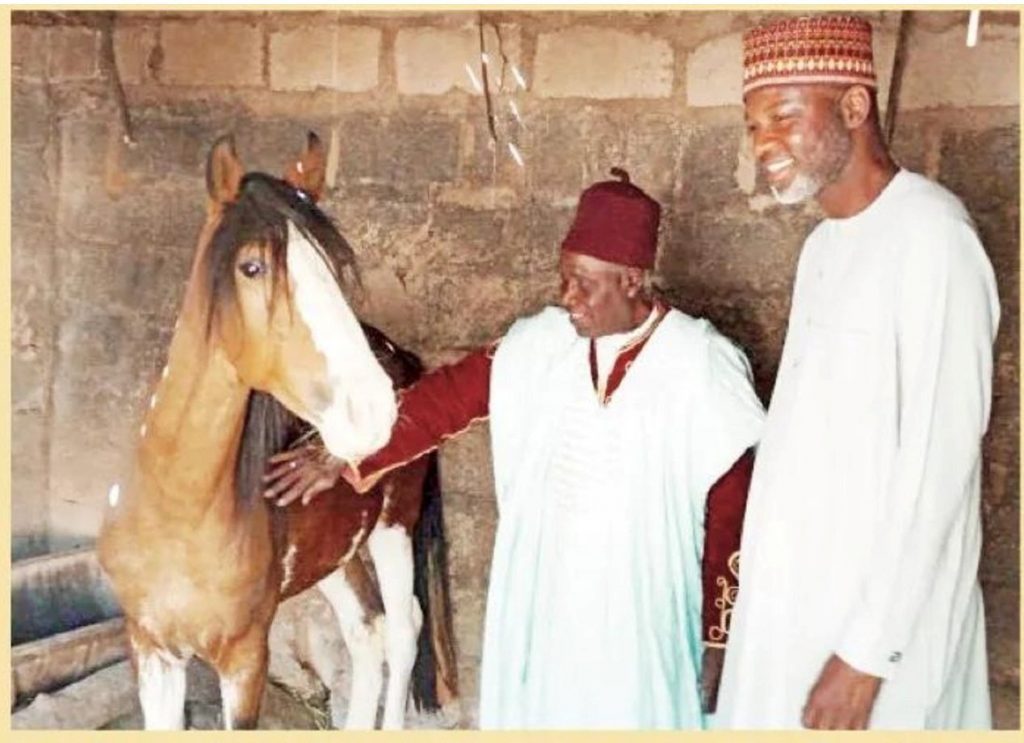 Mshelia (stroking his horse) with his visitor, Umar Midala, at his Marama home Mshelia (stroking his horse) with his visitor, Umar Midala, at his Marama home
Every last day of the year, 31st day of December, the Bura/Babur ethnic group converges on Marama to celebrate the culture of the people.
“The celebration is all about getting the entire Bura people in the Biu Emirate to celebrate the culture of the people. These include Hawul, Biu, Kwaya Kusar and Bayo local governments,” he says.
Before, Shani, which was federated with Biu and Askira to form the Federation of Biu Native Authority in 1957, was part of the emirate, but it has gone its way with a separate emirate, though they both remain culturally close.
Biu is an ethnically plural society. Right from precolonial times, various ethnic groups have domiciled in the territory, including Babur, Bura, Tera, Kanakuru, Chibok, Marghi, Pidllimdi, Jara, among others. Only the Babur and Bura are homogeneous.
Of course, Bura and Babur speak the same language. They share similar vocabularies and proverbs. Perhaps the only difference is in pronunciation. But they have been recognised as the same people and language, according to Dr. Bukar Usman, in A History of Biu, and constitutes the dominant ethnic group in Biu Emirate.
Marama Day Festival is a unifying factor for all, as Saturday Sun reporter, who came a long way from Lagos to Borno State, in search of exotic minority cultures, discovered.
“During the festival, (we have in attendance) all the emirs from the northeast region, with our royal highness, Mai Mustapha Umar II, the chief host. The essence is to get people together, enjoy ourselves, then show our cultural heritage, because we don’t want to forget our traditional ethics,” says Mshelia.
“We display our bow and arrow, old grinding stone, clay mortar pots, traditional dresses like wrapper, caps, among others. If you don’t showcase them, they won’t know some of these things,” he adds.
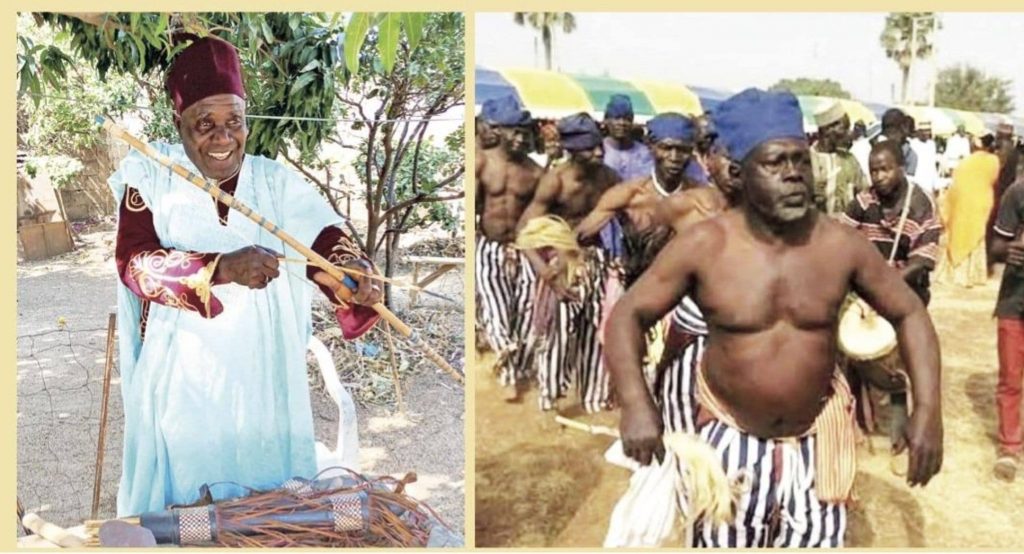 James Mshelia, Lawan of Marama, posing with his bow and arrow; (right) Bonsuwe dancers displaying their skill during the Marama Cultural Day James Mshelia, Lawan of Marama, posing with his bow and arrow; (right) Bonsuwe dancers displaying their skill during the Marama Cultural Day
Why is it important to continue this tradition? Mshelia tells Saturday Sun:
“We don’t want our children and younger generation to forget our past, because we don’t want to forget the history of our tradition.”
Though it’s a cultural event, the festival is conducted in English language, “because many people who have come to participate in the festival may not understand our language. So we have to use English and Hausa languages. Hausa is widely spoken in the entire north, so we use it side by side with English,” says the village head who was educated at the University of New York.
“Also, during the festival, we perform traditional dances like Bansuwe, Waksha Waksha, and Mwar Mwari. Everybody in the emirate has similar dances,” he informs.
Reiterating the importance of the festival, he says: “We perform the Marama Cultural Day, because we want to maintain our status. We don’t want it to die. We want our children to attend and ask questions: What’s this? What’s that?”
Again, the mass gathering is important because of its tendency to serve as a melting pot. “And that’s the best possible way we can revive our culture, because the festival attracts our people from far and near who visit to see spectacular performances” he explains.
Against the backdrop that many indigenous languages stand the risk of going extinct, according to a UNICEF survey, Saturday Sun asks what effort is being put in place to save Bura language from dying.
Charity begins at home echoes in his response. Yes, Mshelia will clock 70 by next year. Though his children reside outside Marama, he has made speaking the local language a must in his home.
“Whenever they step into this house, they leave every other language, including English, and communicate in Bura language. Even their children, who come with them, I ensure they speak in our native language, Bura/Babur.”
Borno State is a heterogeneous society. There are 28 languages, mostly Chadic, spoken as first languages in the state, though many of them are endangered due to the influence of Hausa and Kanuri.
Kanuri, Shuwa Arab and Marghi have a sizable number of native speakers, while some languages are spoken across the border in neighbouring Chad and Cameroon. In the southern part of the state, Bura/Babur is the main Biu-Mandara central Chadic language. Other central Chadic languages include Marghi, Jara, Chibok and Hwana.
Outside Borno, Bura speakers can be found in Garkida and Gombi local government of Adamawa State. An Oxford study puts the number of speakers at over 250,000.
Unfortunately, Bura/Babur isn’t taught in schools in Biu Emirate where they form the majority of native speakers. This hasn’t gone well with Mshelia: “Unfortunately, there is no curriculum for our indigenous language. It’s not taught in schools here, which is not supposed to be so. In Maiduguri, Kanuri language is taught in schools.
“We have been fighting that our local language should be taught from primary to secondary levels.
“In our days, when we attended Marama Central Primary School, we had Bura language in our curriculum, but, now, it’s no longer there. We were taught how to read in Bura language; the school was second to Biu Central Primary School, having been established in 1930.”
You may ask, why is Marama strategic to the Biu cultural renaissance? Mshelia doesn’t want to be egocentric, “but I can say it’s the centre of Bura people. Here, we share boundaries with Shani, Kwaya Kusar. Hawul is in the centre of Biu.”
But organising a cultural festival like this is one thing, luring the youths to show keen interest, away from their phones and computer games, is another big deal.
Mshelia doesn’t see that as an obstacle: “They participate and enjoy it. The festival is unique to them. You see them dancing along, though they don’t know how to dance well, which means they have the interest, because we have inculcated in them that they are supposed to maintain their own culture.”
How has modernity affected traditional society in this part? Mshelia sees the effects in both negative and positive lights. “In everything, there are both positive and negative lights. Positive, western culture encouraged us to get western education. Marama, I can say, is either the first or second in the Biu Emirate in education. While Biu Central Primary School was established in 1924 by the colonial masters, that of Marama was established by the missionaries from England in 1930, and it actually affected us positively.
“In every house you enter in Marama, you must see a graduate. In my house, I have six children, of which five have graduated, while one is about to graduate.”
Mshelia graduated from the University of California in 1984, while his wife graduated from the University of Maiduguri. “It means we are a home of graduates,” he smiles. “In one house in this community, related to me, they have two professors.”
The negative side of the coin includes the dressing of our youths. “I don’t like it,” he says, “because they copy Western people. I like somebody dressing traditionally smart.” Another negative influence, he says, is copying the drinking habits of the Western world when it comes to alcohol.
Though there may be no new programmes slated for this year’s festival, he hopes the number of participants will increase. “Last year, many people came from rural communities. They must have told their friends what they saw, and they may have come to participate.”
If you think the security problem ravaging the northeast is still a big hindrance, Mshelia is quick to allay your fears, as concrete arrangements have been put in place, using the vigilance group, the police and army.
Lest we forget, life in Borno State was disrupted when the Boko Haram insurrection started over a decade ago, coupled with the recent presence of ISWAP. Luckily for people in this community and Biu in general, they have been the least affected by terrorism.
“It’s God that secures; that’s the first thing. It’s God that saved the entire Biu Emirate during those waves of attacks across the state. Apart from God, we had a strong emir, Mai Umar Mustapha Aliu, who died in September, 2020. The present emir is following the same footsteps taken by his father, and we are well secured. Up till now, we didn’t encounter insurgency because of the seriousness of our traditional authority.”
Fearmongering has made many Nigerians believe everywhere in Borno is unsafe and is exploding with bombs. James laughs at the wrong notion. He would like you to put the festival in your annual cultural calendar.
“What makes Biu unique is, first, its natural terrain. Besides, it’s a protected area, because if you are on a mountain you will see an intruder coming. We also have good weather and our emir has created a unity of purpose among all the components.
“There is no problem with religion or ethnicity. We live together peacefully. I am a Christian, but my subjects, as a Lawan include both Christians and Muslims, as well as traditional worshipers. Despite being a Christian, the late emir has allowed me to head this place. So there is no segregation religion wise.”
Mshelia owns a small stable where his lone brown and white spangled horse is fed and sheltered. To own one is something of pride and a status symbol, valued more than a Lamborghini. Suddenly, the horse nickers momentarily with familiarity with a stroke from the master.
The village head also owns a spear that goes with his position. His sojourn to America hasn’t eroded his cultural values. With people like Hon. Mshelia and Bukar Usman, Bura/Babur culture and language may likely survive the doomsday prediction. The signs are already there.
Source: https://www.sunnewsonline.com/bura-babur-how-minority-language-culture-struggle-to-survive-in-northeast/
Viukuthla: Royal cemetery where snakes, bees guard ancestors
By Henry Akubuiro
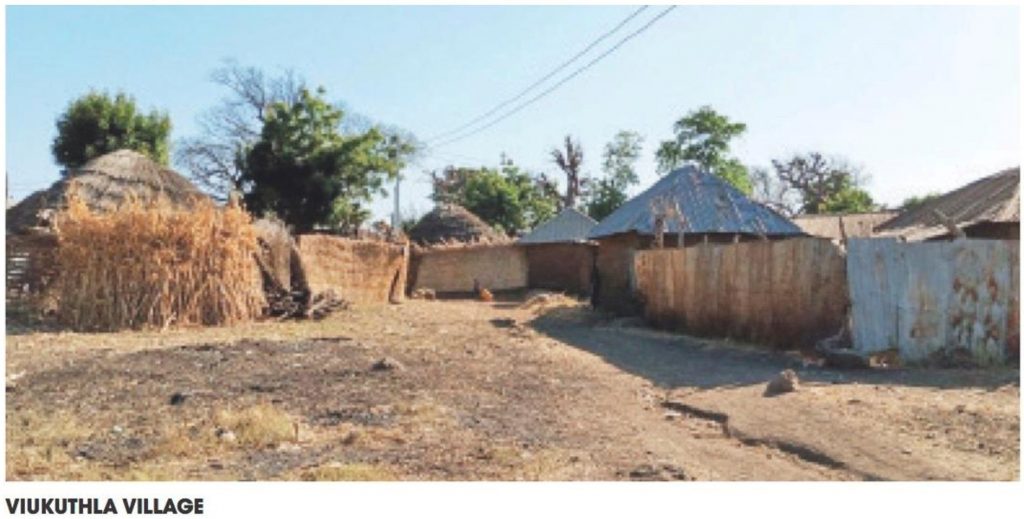
Viukuthla holds a special place in Biu traditional society and culture. It’s a place where the past meets the present. Its rich history spans over hundreds of years as the former capital of Biu in ancient times. Besides, its sacredness is the reason the remains of every Biu king (Kuthli) are brought to the Viukuthla royal cemetery for burial.
However, very little is known of Biu’s royal cemetery to the outside world, compared to the glamour and curiosity that trail the Valley of the Kings, also known as the Valley of the Gates of the Kings, in Luxor, Egypt, where, for nearly 500 years, from the 16th to 11th century BC, rock-cut tombs were excavated for the pharaohs and powerful nobles of the New Kingdom (the 18th to the 20th Dynasties of Ancient Egypt).
There is also a local parallel in the Royal Wadi, a necropolis in Amarna, still in Egypt, where members of the Ancient Egyptian royal family of Amarna, which reigned during the 18th Dynasty, were buried.
For hundreds of years, residents of the small community of Viukuthla in the southern Borno emirate of Biu have shared boundaries with the dead, and the presence of these personages buried in the village leaves mystic traces all around, adding to the curiosity of an ancient African past.
A journey to Viukuthla isn’t the smoothest of rides, be warned. Located five kilometres from Biu, the major town in southern Borno, it takes up to 30 minutes to reach your destination. Two roads lead to Viukuthla, but the most motorable is the one off Gombi Road, opposite a small community market.
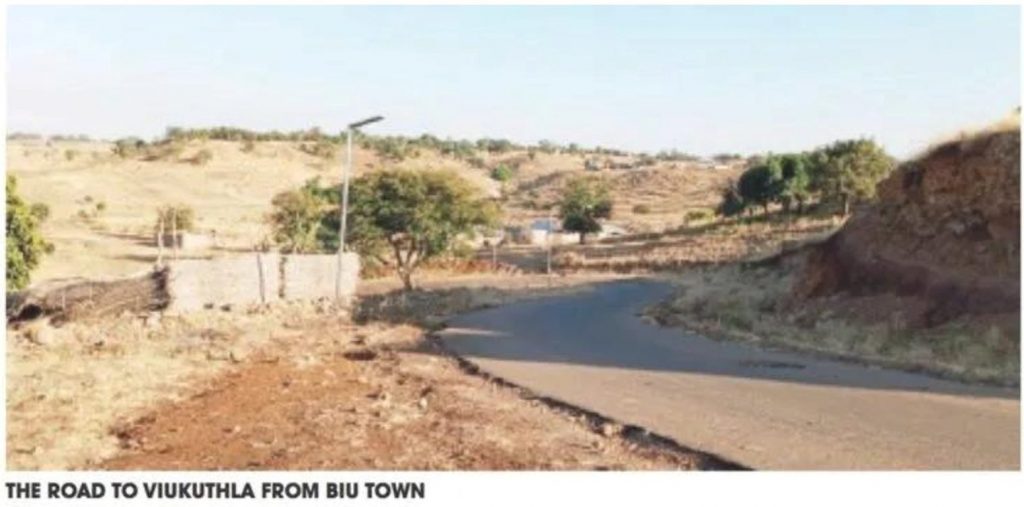
Biu town is located on a high hill. But journeying to Viukuthla, one has to descend contrasting, sloppy valleys that take you to rocky terrain, juxtaposed with grass tablelands. About two kilometres into Viukuthla have been paved, but more than half of the road is untarred, and rocks and pebbles on the road don’t make it any easier to navigate the route.
The only source of transportation to Viukuthla is by keke (tricycle), which carries four passengers to and fro, except for charters by individuals. No matter how new the keke is, be prepared to rock up and down as the tricycle manoeuvres the pebbles on the road.
By the roadside, there are many arresting views to take your mind off the uneasy ride. Hills undulate in the distance. Mango orchards dot the landscape and brown grasses, evidence of mid dry season, present a closer hue to the rocky hills. There is a Fulani settlement by the left and the agrarian nature of locals shows in the ongoing harvest of beans and corn here and there.
An intersection after the third orchard, close to Viukuthla, where a stream snakes its way down a zigzag course, is very remarkable in Biu civilisation: for hundreds of years, pallbearers carrying the body of a late Kuthli from Biu were expected to go no further here. The villagers from Viukuthla would take over the corpse and proceed to the royal cemetery to finish the burial rites as tradition demanded.
Umar Midala, a historian and the reporter’s guide, explained: “This junction is very significant in Biu history. No matter how powerful the king’s family was, they would surrender the corpse to the people of Viukulthla at this point, who would take it for the final burial rites. They would come from the top of that mountain (opposite), after some sacrifices, and go with the body. The monarch’s corpse belongs to them.”
Modernity is gradually creeping into Viukuthla village with a solar light offering electricity, a new mosque, clinic and school, but much of the village portrays a rustic ambience in mud and thatch houses, narrow, untarred streets and low, traditional fences with low eaves. They have existed like this for many years.
Viukuthla royal cemetery, holy bees and snake guards
The Viukuthla royal cemetery is about a third of a football field. It has a block fence with two exits. Giant trees with thick branches and leaves create a dark ambience and a creepy feeling for the fainthearted. Don’t worry, the occupants of this cemetery don’t hurt a fly. But the royal bees and snake guards do.
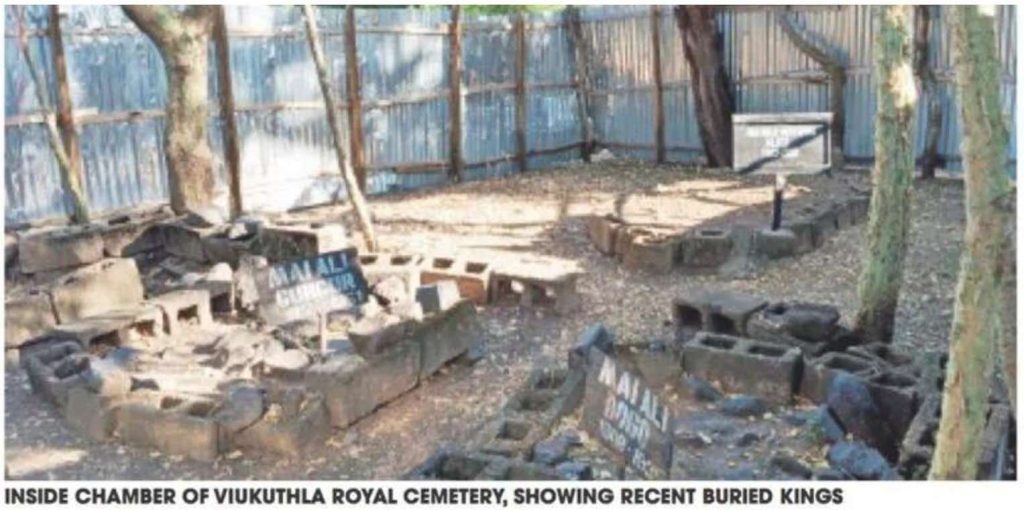
“Not everybody is welcome here,” warned one of the caretakers of the cemetery, Bukar Musa.” However, it wasn’t a direct warning to this reporter but to unofficial intruders. “If anybody forcefully enters the cemetery without permission from us, the bees will descend on him. It’s not just the bees. There are also snakes you can’t see with your naked eyes, but they are here in full force.”
Before the reporter entered the cemetery, the guard had to seek the permission of the ancestors by making some incantations alone. Satisfied that this reporter had no ulterior motive, Musa returned to break the news and ushered him in: “The ancestors said you came here with a clean mind, and you are allowed to come in.”
The royal cemetery is littered with graves left and right, most of them partitioned with pebbles of different sizes. But those of the most recent kings of Biu had names placed on their tombs, identifying their reigns.
These include Mai Ali Gurgur (1935-1951), Mai Ali Dogo (1908-1935), Mai Umar Mustapha Aliyu (1989-2020), etcetera.
Bukar Musa shared the importance of Viukuthla in Biu history: “Viukuthla is founded by the founder of Biu, Yamtarawala, and this is a place where our people first settled before migrating to other places to live. So Viukultha is like the crown of the empire. It used to be the old Biu capital.”
He revealed that the royal cemetery had been in existence for hundreds of years. All the deceased Biu kings were buried here, save for the founder, Yamtarawala, and two others, Kuthli Mari and Mai Madu Aliu, who died in Bauchi. In all, 25 kings have been buried here.
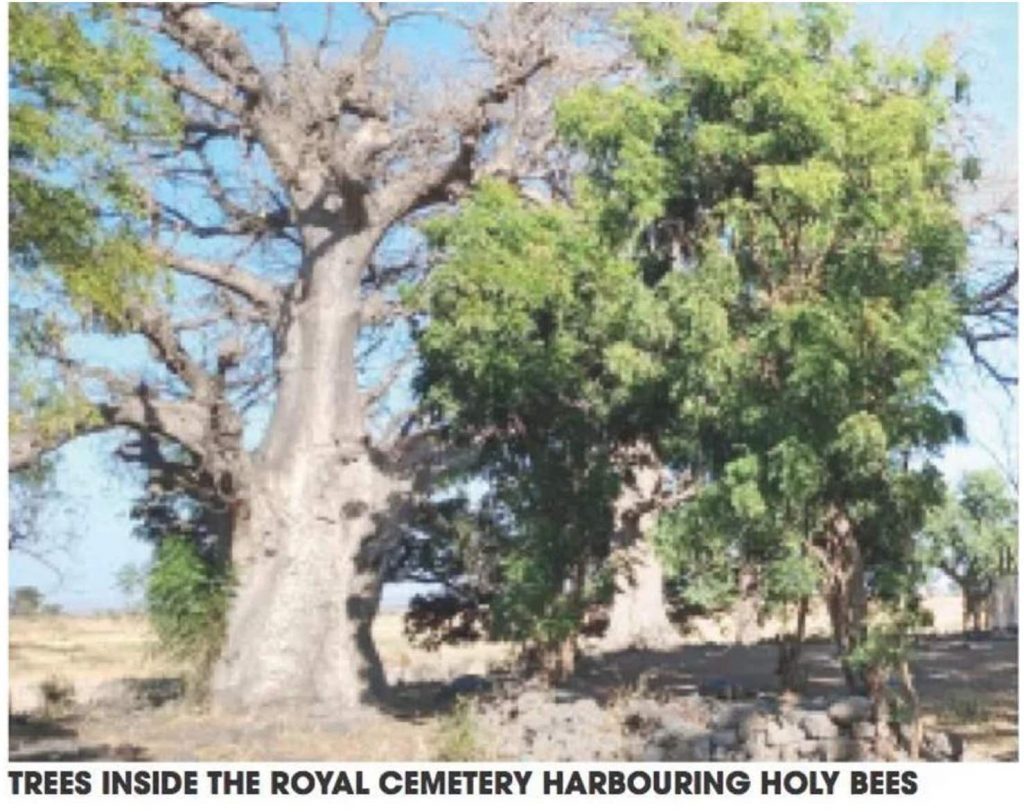
The caretaker pointed to branches on the tree where the royal bees were located, looking down on the visitors. “The holy bees know you are here with good intentions. That’s why you can come in freely,” he said as a bee wheezed past the reporter’s ears from a metre.
Nature has its own way of taking care of deceased personages. Each time a Kuthli dies, the bees will come out in droves to mark the transition. “The bees are treated with care and honour,” said the caretaker, who led the reporter to a gigantic tree with earthenware where water and milk were provided to the royal guards. “We offer the bees water and milk under that tree to drink,” he informed.
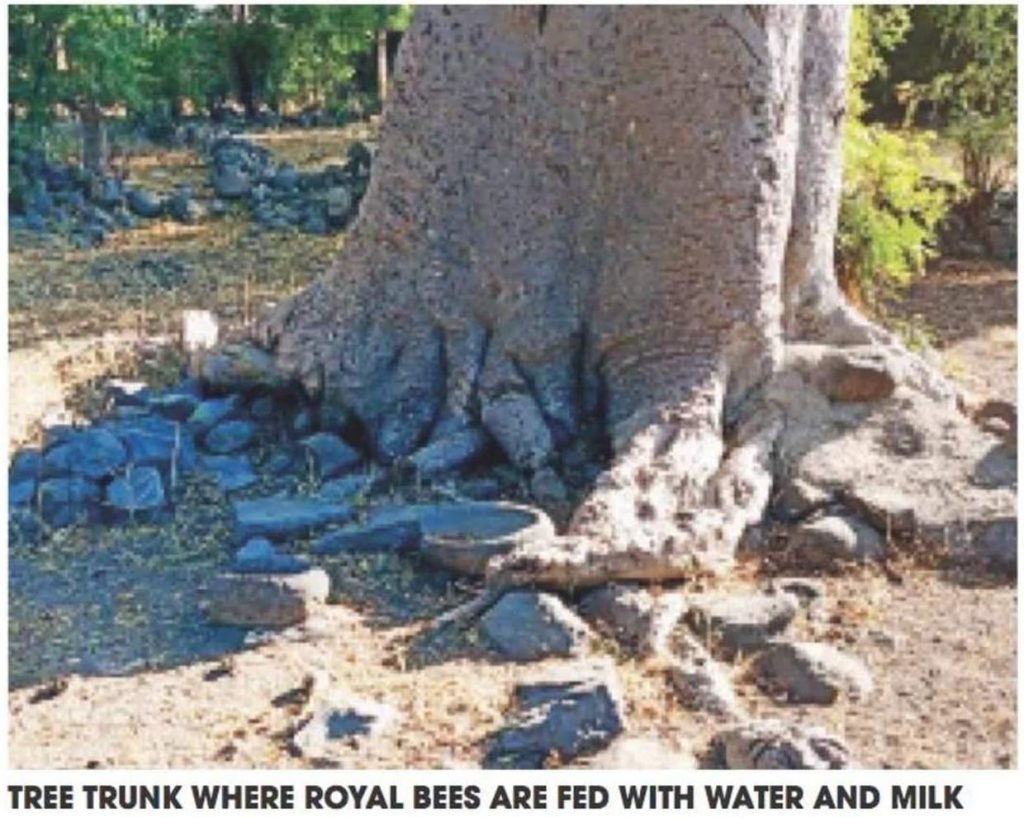
Musa is in his 50s, but he doesn’t know exactly how long the royal cemetery has been in existence. Umar Midala, who is revered in Biu as a historian, bailed him out: “You can trace it back to 1535,” he said, “since the time of Yamtarawala.” However, Yamtarawa, the founder of Biu, wasn’t buried here. He was buried in Limbur.
“Yamtarawala used to come here for hunting,” explained Midala, “and return to Limbur.”
This reporter was curious whether the dead here haunt the living. The answer wasn’t in the affirmative. “They don’t disturb us,” Musa affirmed.
The late king who illuminated the night
Not too long, an extraordinary thing happened at the royal cemetery after the burial of the immediate past Kuthli, Mai Mustapha, who died on September 15, 2020. Though the environment was dark, the Kuthli illuminated the place from the spiritual realm, so the story goes.
Musa recounted the incident: “This place used to be dark. But when the late emir died, three days after his burial, if you came here at night, everywhere would be shining so bright because of the body in the grave, and you might think it was daytime already.”
The Biu royal cemetery isn’t only meant for burying late kings. Once in a while, a living king will visit this part to pay homage to the ancestors and also to enlighten the people of Viukuthla.
“The living Kuthli, after paying homage to the Kings, will sit under the baobab tree to lecture the Viukuthla community. He will slaughter a ram or a cow and give it out as charity so that people will take it to their houses for consumption,” he said.
On any other day, villagers are not permitted to enter the royal cemetery. Visiting here is strictly by invitation. “You can only see the bees buzzing up there, but you can’t see the snakes, which are also around us, protecting here,” he reiterated.
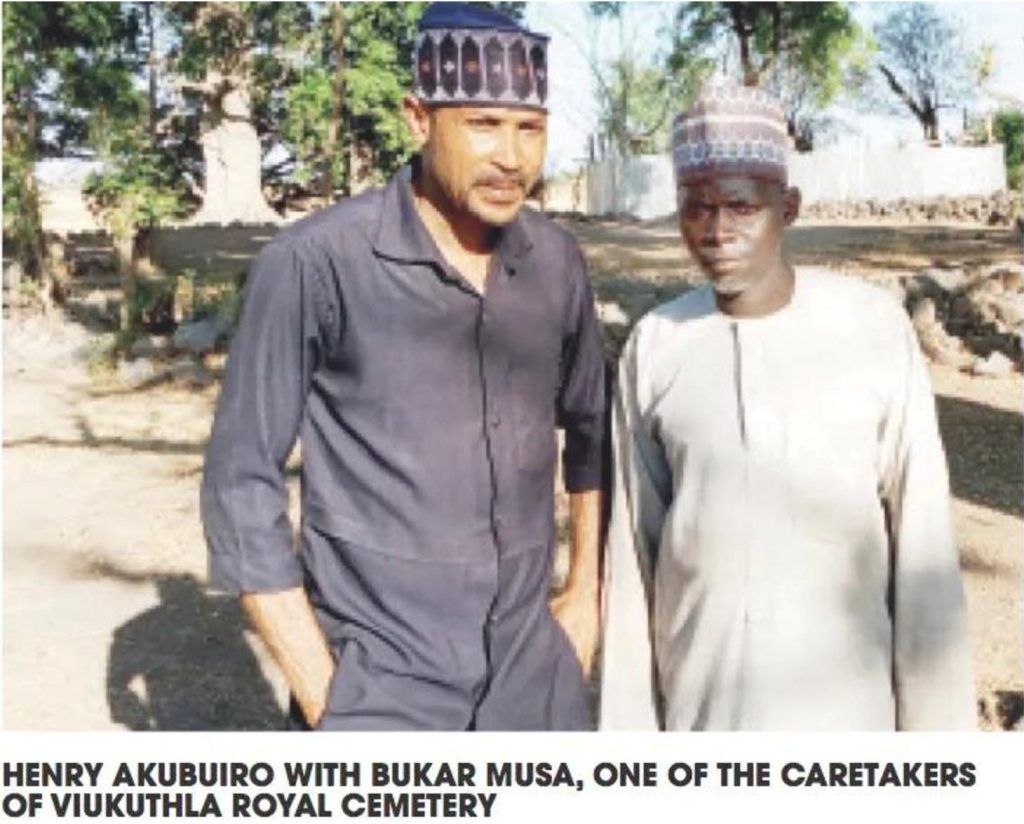
How Biu kings are buried
Until the death of a serving Kuthli is confirmed, it is forbidden for anybody to circulate the news. The news will be announced by the royal family by saying, Hyel Knthla, meaning, “Heaven has fallen,” to which Biu will be thrown into mourning.
For instance, when the 27th Kuthli (Mai Mustapha Aliyu), died in 1989, the palace gates were thrown open.
Renowned author and folklorist, Dr. Bukar Usman, an indigene of Biu, recalled: “Sympathisers, men and women, young and old, freely accessed the palace to pay their condolences to the bereaved family. Women trooped to the wives of the deceased and sat around solemnly while men likewise went to the male members of the royal family led by the heir-apparent who received the condolences.”
However, the 26th Kuthli was buried according to Islamic rites. “His body, wrapped in a white cloth and put on a bamboo stretcher, was brought out from the palace and placed in front of the palace for everybody to see the once powerful ruler of the community for over 30 years simply dressed up ready for interment was enough lesson to people to appreciate the inevitability of death, no matter one’s status in life,” he said.
The body was subsequently moved in a crawling motorcade to Viukultha, five kilometres away, accompanied by kingmakers. Besides, “many, including children, were going to satisfy their curiosity (at Viukuthla) as to how the internment would be conducted. It was surely a spectacle of their time.”
Another interesting spectacle witnessed at Viukuthla during the 1989 burial of the king was the welcome party of women from the royal family singing mournful songs.
“To them, the deceased was merely returning home. That was why even the removable covering of the remains of the deceased was kept by the caretakers of Viukulthlla. It could only be taken back by the new kuthli if he so wished upon payment of compensation,” recalled Usman.
The welcome party song of the female royal members was laden with meanings. Known as thlimfwal (praise) in Bura language, they enjoined the departed king to greet those who had gone before him, among others. As the praise song was being made at the Viukuthla burial ground, beniseed (sesame seed), a sacred seed in Biu, was sprayed, an indication that the deceased was being sent to greet all his predecessors.
On that occasion, a big snake was seen in a nearby shrub wriggling in welcome to the deceased. Usman said perhaps the snake’s appearance was of symbolic importance. He added: “Biu traditionalists say such snakes usually appeared at the palace and the Whu River in Biu town on the death of every Kuthli of Biu.”
This was in contrast to the burial of the 25th Kuthli of Biu, Saturday Sun learnt, Mai Ari Gurgur, in the early 1950s where his corpse was hand-carried on the stretchers down the Viukuthla’s valleys. The funeral procession, said Usman, was on foot, accompanied by drumming and blowing of algeita, stopping a few places to perform rites here and there.
In Biu, the burial of a Kuthli is everybody’s business, with mass participation from the high and low. After the burial of the king, condolences continue till the appointment of a new king, which occurs three days after the death of a former Kuthli. He is turbanned immediately his selection is announced.
Goodbye, Viukuthla
The bumpy ride to Viukuthla experienced by a first-time visitor or anybody who seldom comes to this part could be uncomfortable, but it’s worth the trip in the end with its rich past. Here lies more than 500 years of ancient Nigerian history comparable to the Egyptian Valley of Kings in Luxor. As this reporter set to depart, the royal bees buzzed past and made a U-turn to where they came from, without stinging anybody. The ancestors weren’t angry at all, as you could see.
Source: https://www.sunnewsonline.com/viukuthla-royal-cemetery-where-snakes-bees-guard-ancestors/
|